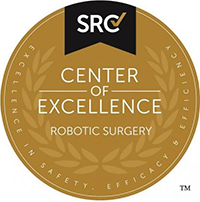Hysterectomy
A hysterectomy is surgery to remove your uterus (partial hysterectomy) or your uterus plus your cervix (total hysterectomy). If you need a hysterectomy, your doctor might recommend robot-assisted (robotic) surgery. During robotic surgery, your doctor performs the hysterectomy with instruments that are passed through small incisions in the abdomen. This includes a camera with a magnified, 3D view which allows for greater precision, flexibility and control. When you have a minimally invasive hysterectomy via vaginal, laparoscopic, or robotic approaches, you’re likely to have less pain and lose less blood than you may with an open abdominal surgery (large abdominal incision). You’ll also be able to resume normal daily activities more quickly than you would after open surgery.
Myomectomy
Robotically-assisted myomectomy is a type of laparoscopic procedure that offers a minimally invasive way for surgeons to remove uterine fibroids that may be causing symptoms, including heavy bleeding, pelvic pain, and infertility, while preserving the uterus. The procedure may result in less blood loss, fewer complications, a shorter hospital stay, and a quicker return to activities than you would with open surgery with a larger incision on the abdomen.
Excision of endometriosis
A woman’s uterus is a muscular organ with several layers. The endometrium is the tissue that lines the uterus and is what thickens each month in preparation for pregnancy. When a fertilized egg does not implant in the lining, the endometrium breaks down and sheds, which is called menstruation. Endometriosis is a chronic condition that occurs when tissue that looks and behaves like endometrial tissue grows outside of the uterus. This creates lesions, or implants of endometriosis that can occur in the pelvic or abdominal cavity. Because this tissue is in the incorrect location and cannot be shed monthly, these implants continue to grow and thicken in response to normal hormonal changes in the body. They can also cause the formation of adhesions or scar tissue. These processes can cause painful periods, cramping or pelvic pain, irregular bleeding, painful intercourse, and urinary and intestinal symptoms. Some patients opt for medical management options while others prefer surgery. Laparoscopic and robotically-assisted excision of endometriosis is a minimally invasive procedure where all visible implants of endometriosis are removed to help improve the patient’s symptoms.
Sacrocolpopexy
A sacrocolpopexy is a surgical procedure to treat specific types of pelvic organ prolapse. Pelvic organ prolapse occurs when one or more of your pelvic organs protrudes into the vagina. These organs include the uterus, bladder, and lower part of your intestines. Prolapse typically occurs when the muscles and tissues that normally support your pelvic organs become weak. During a sacrocolpopexy, your surgeon attaches a synthetic mesh onto the pelvic organs that have prolapsed. This mesh is then attached to a bony area in the lower part of your spinal column to help keep the pelvic organs in place. This procedure can occur with or without a hysterectomy. Restoring your pelvic organs to their normal position helps relieve side effects of prolapse like a vaginal bulge, pelvic pressure, pain with intercourse, leaking urine, or constipation. Many patients are candidates for a robotically-assisted sacrocolpopexy, which is a minimally invasive approach with a quicker recovery and excellent long-term results.

